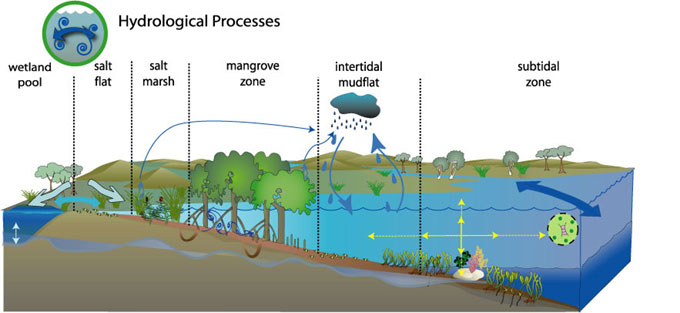
| Surface water flows off the catchment into wetland pools and the estuary | Evaporation from water bodies | ||
| Groundwater – surface water exchange (Winter, 1999) | Precipitation | ||
| High tides, storm surges, floods and run-off events connect wetland pools to estuaries (Sheaves et al, 2006) |  |
Tides – including spring and neap | |
| Crab burrows alter water flows (Ridd, 1996) | Freshwater and marine water are mixed and exchanged in estuaries | ||
| Evapotranspiration from vegetation (Hughes et al, 1998) |
References:
- Connolly, R.M., Currie, D.R., Danaher, K.F., Dunning, M., Melzer, A., Platten, J.R., Shearer, D., Stratford, P.J., Teasdale, P.R., Vandergragt, M. 2006 Intertidal wetlands of Port Curtis, an industrialised coastal city in central Queensland, Australia: ecological patterns and processes and their implications, Technical Report 43: CRC for Coastal Zone Estuary and Waterway Management, Brisbane, Queensland, Australia.
- Hughes, C.E., Binning, P., Willgoose, G.R., 1998, Evapotranspiration Characterisation of the hydrology of an estuarine wetland, Journal of Hydrology, Volume 211, Number 1, pp. 34-49.
- Sheaves et al, 2006 [in press]
- Ridd, P.V. 1996, Flow through animal burrows in Mangrove creeks, Estuarine Coastal and Shelf Science, 43 (5): 617-625.
- Winter, T.C., 1999, Relation of streams, lakes, and wetlands to groundwater flow systems, Hydrogeology Journal, 7 (1): 28-45.


